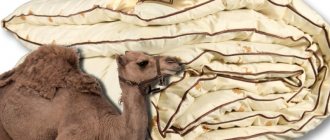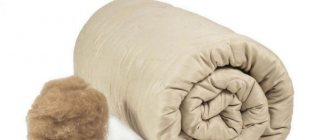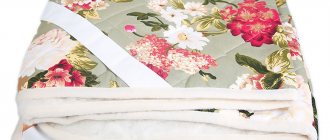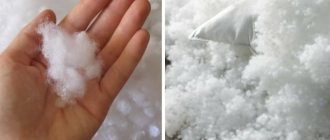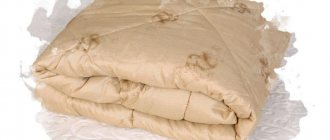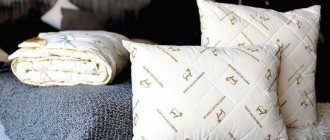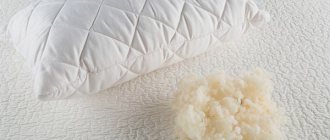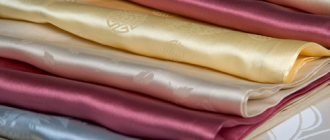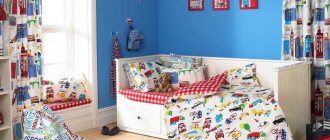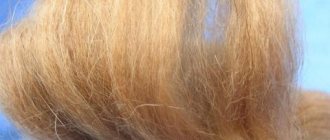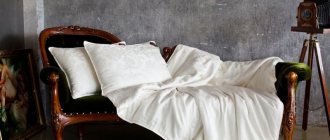Blankets made from camel and sheep wool traditionally lead in consumer ratings. People choose them based on different aspects: some value hypoallergenicity, while others do not like prickly fiber. Which natural blanket will be more comfortable and warmer - camel or sheep?
Things will look stylish in the interior of any bedroom
What are the benefits of a wool blanket?
Camel or sheep bedspreads are made from natural wool. It is preferred to synthetic fibers for the following advantages:
- Comfortable, restful sleep. In hot weather, the material perfectly absorbs moisture and allows air to pass through, and in cold weather it retains heat efficiently.
- Products made from wool are pleasant to the touch and therefore have a calming effect. The therapeutic and prophylactic properties of natural yarn for colds and vascular diseases are widely known. The material relieves pain from radiculitis and migraines.
- No static electricity.
- Good compatibility with bedding stuffed with airy swan down (pillows, mattress covers), which creates additional comfort.
The service life of a natural fiber blanket with proper care is about 10–12 years.
A wool blanket is not only beautiful, but also warm and comfortable
Price range
How much a product in this category costs depends on its following characteristics:
- filler quality;
- density;
- size;
- forms;
- manufacturer.
If you buy products from well-known brands, you will have to pay a decent price. You should know that a natural and high-quality item cannot be cheap. Therefore, do not buy goods on promotions or sales.
Approximate price range:
- from 1,500 rub. - on a children's bed;
- from 4,000-7,000 rub. — for a single bed;
- from 10,000 rub. - the same size, but made in Mongolia;
- from 11,000 rub. - luxury products.
In most cases, price is an indicator of quality. And if they try to sell you a cheap product by any means, then pass by. The product will probably be of poor quality.
Camel or sheep: which blanket is warmer
By standards, a camel blanket is warmer than a sheep blanket. This is due to the structure of the hairs: unlike sheep’s, camels’ hairs are hollow, which significantly improves thermal insulation. At the same time, the options made from the down of the Mongolian Bactrian (Bactrian camel) are considered the most warming and retain heat.
However, a sheep's blanket is not inferior to a camel's in maintaining dry heat. Merino wool, which is obtained from Australian fine-wool sheep, stands out especially. The fiber is thin, but durable, warming and non-prickly.
Medicinal properties
Both materials are safe for human health. But only one blanket has healing properties - a woolen one. Camel blanket shown:
- for neuralgia;
- joint pain;
- poor blood circulation;
- weak immunity;
- restless sleep;
- osteochondrosis;
- back pain;
- inflammatory processes.
At the same time, a bamboo blanket is more beneficial for allergy sufferers, infants and people with bronchial asthma.
Camel wool products
The downy undercoat of young animals is most often used to make bedding. This material is expensive, but has increased softness, which will appeal to people with sensitive skin and children.
The wool of Mongolian camels is considered to be of high quality - it is very thick and delicate even on adult animals. The wool of Chinese and Kazakh animals will be appreciated by lovers of causticity and pleasant heaviness.
Models are distinguished by quality, durability and warmth
Advantages
Buyers often choose the following blankets:
- for the absence of chemical pigments and dyes in the composition due to the low colorability of the villi;
- for natural pastel colors (from light milky to cream, beige, brown, ocher);
- for high breathability;
- for maintaining dry heat;
- for lightness and ergonomics;
- for fiber strength, elasticity;
- for the absence of deformation over time;
- for durability with good care;
- for minimal electrification;
- for its therapeutic effects (antiseptic and anti-inflammatory effect due to natural wax - lanolin, improvement of blood and lymph flow).
Even clothing for sailors and astronauts is made from camel down, which indicates the highest quality and comfort of the material.
Flaws
With all the advantages of camel wool bedspreads, they also have disadvantages:
- high price;
- allergic reactions due to natural material;
- need for delicate care;
- causticity of the material.
Varieties of camel blankets
Depending on the characteristics, there are several types of camel bedspreads:
- By structural features: woven, fibrous. The first ones are thin and light, they are often used as blankets, backings and covers for furniture. The second type is more dense, since the raw material is made using the hot method, in which the wool is held together very closely. The fiber is placed in a fabric cover and stitched using a special technology, forming a thick product.
- According to the firmware method. Quilted ones are sewn with parallel machine stitches approximately 5 cm apart. Cassette stitching - alternating transverse and longitudinal stitches. Karasteppe - products with small frequent cells.
- By density: lightest (from 160 g/m²), thin (200–220 g/m²), standard (350 g/m²), winter blanket (420–500 g/m²), extra warm (up to 900 g/m²).
Camel down is widely known for its healing properties.
On the label, the degree of density is marked with dots (from 1 to 5, where 1 is the lightest option).
Main Dimensions
Common sizes:
One and a half:
- 140x205 cm;
- 145x205 cm;
- 150x210 cm;
- 155x215 cm;
- 160x220 cm.
Double:
- 172x205 cm;
- 175x205 cm;
- 180x210 cm;
- 200x220 cm;
- 240x220 cm.
Children's:
- 110x140 cm;
- 100x135 cm;
- 100x140 cm;
- 100x150 cm.
European standard:
- 155x215 cm;
- 172x205 cm.
Sheep wool blankets
A fleece weighs about twice as much as a camel. Such accessories have their connoisseurs: a sheepskin blanket creates a feeling of security and calms the nervous system. In the old days, fleece bedspreads were even used to nurse premature babies.
The wool of coarse-wool sheep is used in production. In animals of these breeds, when combing, the hairs are removed along with the thick undercoat, which is the basis for the bedspreads.
Airiness, lightness and warmth are the main qualities of sheep wool
pros
The value of sheepskin products is determined by a list of advantages:
- high hygroscopicity - the ability to absorb all moisture even in the heat;
- good thermal conductivity;
- hygiene due to natural lanolin, which prevents the destruction of the fabric by pathogenic microorganisms;
- self-cleaning properties: products made from fleece repel dirt, and visible dirt can be shaken off or removed by airing;
- possibility of operation in any weather;
- increased elasticity and softness due to the natural twisting of hairs into small curls;
- at an affordable price.
To find out the thermal conductivity of a sheepskin blanket, you need to read the labeling. One circle on the tag indicates sheepskin products for hot weather, two or three for heated places, four or five for the warmest, for harsh climates.
Minuses
Despite the many advantages, technologists advise to carefully approach the purchase of a sheepskin bedspread due to the following disadvantages:
- allergy due to natural material;
- the specific smell of sheep down;
- the need for regular ventilation and shaking;
- maximum accuracy in operation and associated difficulties in maintenance;
- heaviness, lack of ergonomics.
We recommend reading: Description and composition of a flannelette blanket, types and sizes.
Types of sheep blankets
Sheepskin products are divided into:
- Open and closed: the first look like a blanket or a standard bedspread (on one side - sheep's fleece, on the other - satin, cotton or calico fabric). In the second option, the sheepskin is placed in a textile cover and stitched.
- For double-sided and single-sided: the first option is considered expensive due to the greater wool consumption;
- For cassette and karosteppe: cassette are closed types of bedspreads in which the fabric is stitched with longitudinal or transverse large stitches. The Karostep sections are much smaller: the material inside the cover does not fall off and is held tighter.
- By density: light (up to 200 g/m²), classic (up to 300 g/m²) and standard (up to 400 g/m²).
Double-sided sheepskin blankets are popular despite their high cost
It is recommended to buy closed-type bedspreads with bamboo duvet covers. Bamboo fabric prevents allergies and dust mites.
Useful to know, read: — Where and how can you wash a sheep’s wool blanket at home?
How to properly care for a wool blanket
Caring for accessories made from sheepskin and camel fiber is almost identical. Since both types are sewn from natural materials, their proper use involves:
- systematic ventilation and shaking (outdoors);
- storage in a dry place that is well ventilated;
- seasonal storage not in polyethylene, but in bamboo, linen or cotton covers;
- drying on a flat horizontal surface in a straightened form (without folds, creases) - do not iron.
The fundamental differences in care between camel and sheep options are only in washing. If camel wool accessories can be machine washed delicately, at a low temperature and without resorting to spinning, then it is better to wash fleece bedspreads by hand or even dry-clean them.
To get rid of stubborn deep stains, stain removers for natural wool fabric are used.
Blankets made from natural down are difficult to care for, but they will please their owner for a long time
Interesting fact
Camel cubs up to one year old are white in color. For many centuries, camel hair has been used as a medicine for various diseases. In Greece, it was used to successfully relieve rheumatism by applying a little wool soaked in a special mixture to the back. In ancient Rome, sprains and bruises were treated by applying a woolen bandage, which was soaked in a herbal decoction. Modern medicine also tends to adhere to traditional methods of using camel hair.
Caring for camel wool bedding:
- Bedding with camel hair should be washed with warm water at a temperature not exceeding 30C;
- It is necessary to use detergents that are specifically used for natural wool products and contain lanolin extract;
- Products with camel wool should not be wrung out in a machine, and when drying, avoid direct sunlight;
- Items should be taken out into the fresh air for ventilation; this has a beneficial effect on wool items in high humidity.
What to look for when choosing a wool blanket
It is recommended to choose bedspreads made from natural sheepskin or camel leather based on general parameters and appearance. Affiliation will be:
- with a homogeneous fabric (the fibers do not come out of the textile cover);
- soft to the touch (the older the sheep or camel, the spikier and coarser the wool);
- well processed (no protruding threads or uneven seams);
- have a specific aroma of wool, and not chemical, unpleasant, foreign odors;
- have a quality certificate.
Allergy sufferers need to look at the cover: it should be made of natural, breathable fabric. This will filter out small particles that act as allergens.
Important! Brands attach a sealed bag to natural blankets, inside which the buyer can examine in detail the quality of the wool filling.
Before purchasing a bedspread, it is recommended to choose its thickness. Detailed parameters, including seasonality and care features, are indicated on the label.
The manufacturer places all important information about the blanket on a tag or label.
Cure for back pain
Unfortunately, few of us have never experienced pain in the spine, lower back or joints. People noticed the beneficial effects of sheep's wool and the analgesic effect of dry wool warmth many years ago. Sleeping under such blankets is recommended for anyone who experiences discomfort after a hard day in a sitting position or has diseases of the musculoskeletal system.
Carefully! In pursuit of savings, it is easy to run into an outright fake or low-quality item. For closed-type blankets, not only wool is important, but also the material of the cover. An honest manufacturer always indicates what the product is made of. Models that are too cheap (below 2,000 rubles) may turn out to be mixed, with the addition of synthetics, which means they are less warm, heavier, non-therapeutic, and even harmful.
The best manufacturers of camel and sheep blankets
The quality of blankets often depends on the brand. Popular manufacturers of camel and sheep bedding are the following companies:
- “Magicwool” is a brand that sews items for the home from high-density natural wool made in Italy.
- "Renome" - the company has a large selection of warm winter blankets made of camel or sheepskin with a non-trivial design.
- "Holti" - the manufacturer sews products from sheep's down; double-sided versions with prints are especially popular.
- "Primavelle" - environmentally friendly products made according to European design.
- "Ol-tex" - the company creates wool bedding in both insulated and lightweight versions with exclusive types of stitches.
The company's assortment includes many blankets with original designs and patterns.
If the question arises which blanket is better, camel or sheep, then you should focus on personal feelings and needs. Before purchasing directly, it is useful to study the characteristics of materials and operating rules.
Thickness matters
The thickness determines, first of all, the weight of the blanket, as well as how well it will retain heat inside. Thin camel linen is pleasant to cover during warm seasons. For winter, a thick bedding is a good choice.
For camel fillers, the thickness ranges from 200 grams per square meter to just over 400 grams. These generally accepted parameters are considered very useful. They will help keep a person in a cool room warm on a cold day.
The closed-type quilted sheepskin is also thick and very warm. They are created from a layer completely filled with wool and a fabric cover, stitched together.
The thicker the wool layer, the better. Products made from sheep wool are easily selected for any season. There are light, not too thick (100-150 grams per square meter), universal (250-300), standard (350-400). The thickest ones reach up to 800 grams per square meter.
